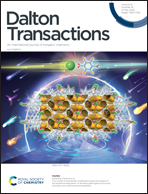Rethinking the molecular structures of WVIOx sites dispersed on titania: distinct mono-oxo configurations at 430 °C and temperature-dependent transformations†
Abstract
The structural properties of the (WOx)n phase dispersed on TiO2 (P25, anatase) at surface densities of 0.5–4.5 W nm−2 (i.e. up to approximately a monolayer) were explored by using in situ Raman and FTIR spectroscopy, in situ Raman/18O exchange and Raman spectroscopy in static equilibrium at temperatures of 175–430 °C. Deciphering the temperature and coverage dependence of the spectral features under oxidative dehydration conditions showed that (i) the (WOx)n dispersed phase is heterogeneous at 430 °C consisting of two distinct mono-oxo species: Species-I with C3v-like O![[double bond, length as m-dash]](https://www.rsc.org/images/entities/char_e001.gif) W(–O–)3 configuration (W
W(–O–)3 configuration (W![[double bond, length as m-dash]](https://www.rsc.org/images/entities/char_e001.gif) O mode at 1009–1014 cm−1) and Species-II with C4v-like O
O mode at 1009–1014 cm−1) and Species-II with C4v-like O![[double bond, length as m-dash]](https://www.rsc.org/images/entities/char_e001.gif) W(–O–)4 configuration (W
W(–O–)4 configuration (W![[double bond, length as m-dash]](https://www.rsc.org/images/entities/char_e001.gif) O mode at 1003–1009 cm−1); (ii) the O
O mode at 1003–1009 cm−1); (ii) the O![[double bond, length as m-dash]](https://www.rsc.org/images/entities/char_e001.gif) W(–O–)3 site is formed with first order of priority and its formation ceases after the complete consumption of the most basic hydroxyls that are titrated first, hence is abundant at low coverage (<1.5 W nm−2); (iii) the O
W(–O–)3 site is formed with first order of priority and its formation ceases after the complete consumption of the most basic hydroxyls that are titrated first, hence is abundant at low coverage (<1.5 W nm−2); (iii) the O![[double bond, length as m-dash]](https://www.rsc.org/images/entities/char_e001.gif) W(–O–)4 site prevails over the O
W(–O–)4 site prevails over the O![[double bond, length as m-dash]](https://www.rsc.org/images/entities/char_e001.gif) W(–O–)3 site at medium to high coverage (≥2 W nm−2) and partially occurs in associated (polymerized) coverages above 2 W nm−2; (iv) lowering the temperature in the 430 → 250 → 175 °C sequence does not affect the structural and vibrational properties of O
W(–O–)3 site at medium to high coverage (≥2 W nm−2) and partially occurs in associated (polymerized) coverages above 2 W nm−2; (iv) lowering the temperature in the 430 → 250 → 175 °C sequence does not affect the structural and vibrational properties of O![[double bond, length as m-dash]](https://www.rsc.org/images/entities/char_e001.gif) W(–O–)3 but leads to the gradual transformation of the O
W(–O–)3 but leads to the gradual transformation of the O![[double bond, length as m-dash]](https://www.rsc.org/images/entities/char_e001.gif) W(–O–)4 site to a di-oxo (O
W(–O–)4 site to a di-oxo (O![[double bond, length as m-dash]](https://www.rsc.org/images/entities/char_e001.gif) )2W(–O–)3 site (with a symmetric stretching mode at ∼985 cm−1) and the partial association of adjacent O
)2W(–O–)3 site (with a symmetric stretching mode at ∼985 cm−1) and the partial association of adjacent O![[double bond, length as m-dash]](https://www.rsc.org/images/entities/char_e001.gif) W(–O–)4 units. All temperature-dependent structural/configurational transformations are fully reversible in the 430–175 °C range and are interpreted at the molecular level by a mechanism involving water molecules retained at the surface that act in a reversible temperature-dependent mediative manner resulting in hydroxylation (upon cooling, e.g. to 250 °C) and dehydroxylation (upon heating, e.g. to 430 °C). The Raman spectra obtained for the hydroxyl region confirm the successive hydroxylation/dehydroxylation steps during temperature cycles (e.g. 430 → 250 → 430 °C). One can tune the speciation of the dispersed (WOx)n phase under dehydrated conditions by appropriate control of temperature and coverage.
W(–O–)4 units. All temperature-dependent structural/configurational transformations are fully reversible in the 430–175 °C range and are interpreted at the molecular level by a mechanism involving water molecules retained at the surface that act in a reversible temperature-dependent mediative manner resulting in hydroxylation (upon cooling, e.g. to 250 °C) and dehydroxylation (upon heating, e.g. to 430 °C). The Raman spectra obtained for the hydroxyl region confirm the successive hydroxylation/dehydroxylation steps during temperature cycles (e.g. 430 → 250 → 430 °C). One can tune the speciation of the dispersed (WOx)n phase under dehydrated conditions by appropriate control of temperature and coverage.

- This article is part of the themed collection: Spotlight Collection focused on Inorganic Chemistry in Greece


 Please wait while we load your content...
Please wait while we load your content...